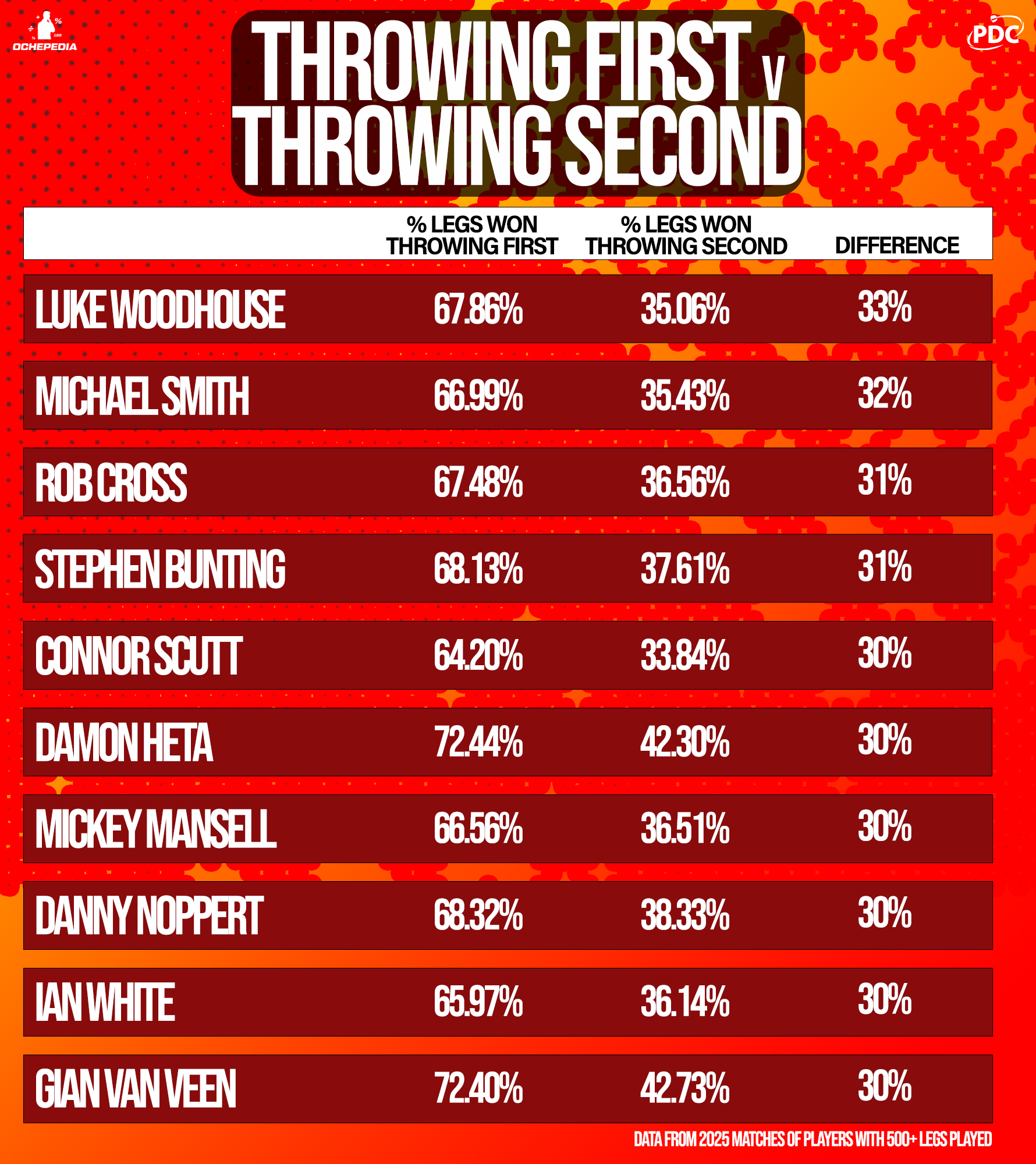
In his latest column, PDC Stats Analyst Christopher Kempf analyses data from 2025 to discover how throwing first or second in a leg can impact player performance.

It is an ironclad law of darts that legs played against the throw are about 60% harder to win than legs played when throwing first.
This advantage (or disadvantage) is reduced somewhat by the uncertainty of 'doubling-in' at the World Grand Prix, but in all other 501 darts events, players will, on average, win only 38% of the legs in which they throw second.
Unless players somehow attempt - and succeed - to be more accurate in certain legs, any difference in performance between legs throwing first and second is likely to be the result of an unconscious reaction to these circumstances.
How can we determine whether or not a player is especially good on throw or not?
Looking at the averages for entire legs will not do: players throwing first are more likely to have attempted doubles, and thus have lower averages than players for whom every dart thrown in a leg has a chance to score 60 points.
Any statistics related to finishing or doubles must account for the fact that many players throwing second will not attempt finishes at all, especially at the highest levels of the game.
However, almost without exception, players will have three scoring visits at the start of a leg. One of the few factors that could explain how much a player scores in those visits - since the beginning of a leg is so similar to all others - is whether they are working against their opponent's throw.
We would not expect most players to exhibit dramatically different averages between the two scenarios, but those few who score dramatically better with throw or against could be said to prefer one of the other.
Most of the established powers and active World Champions have a clear bias toward stronger performances with throw.
Luke Littler, Michael van Gerwen, Gary Anderson, Raymond van Barneveld, Luke Humphries and Peter Wright have all averaged at least one point more per visit in scoring when throwing first than they do against throw.
Why should this be so? On the one hand, one point per visit to the board is not enormous, but it is significant enough, and common enough amongst veteran players to suggest that the embarrassment of having one's throw broken becomes more acute with age and experience.
Though this particular correlation does not imply that a higher average with throw does not guarantee more match wins, it remains the truth that the vast majority of TV titles won by active players belongs to players who score better when throwing first.
The only player with as strong a preference for throwing second as that of the aforementioned players for throwing first is Gerwyn Price, who reaches a score of 183 after 9 darts thrown when throwing first, and 179 when throwing second.
Is Price affected by a different psychological effect? Does the excitement of breaking throw appeal to this volatile player more than it does to the more conservative Raymond van Barneveld?
Why are more players not like Stephen Bunting, who has almost exactly the same scoring average regardless of whether he throws first or second?
Even the players with the most extreme preferences for throwing first or second, like Justin Hood, who reaches a score 13 points lower after nine darts thrown when he is throwing first, or Brendan Dolan, with a 12-point preference for throwing second, do not actually win a substantially larger proportion of those legs than the average PDC player, or even win many more legs according to their throw preference.
It cannot be the case that scoring 12 points more in a particular subset of legs could put one at a disadvantage, but that difference does seem to be disconnected from doubles accuracy and other factors connected with winning the leg.
Have we discovered a completely meaningless statistic? If players can't convert better scoring into winning more legs, of what use is it? It may provide us a glimpse into players' psychology.
If it is immaterial to a player's actual chances of a winning to reach a 10 point lower score after nine darts thrown, we can provide few other explanations for why a player would average more throwing first or second than that they have a predisposition to strongly defend their throw, or attack their opponents', as an unconscious bias factoring into the totality of a player's strategy.
In a game so determined by psychological factors, such glimpses can be more valuable than they would appear at first glance.
Follow Christopher on Twitter @ochepedia